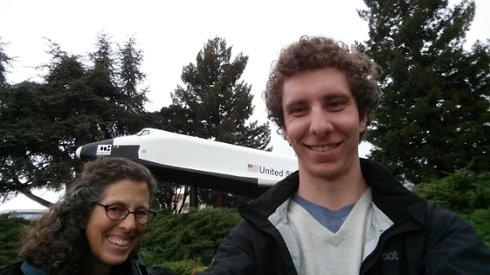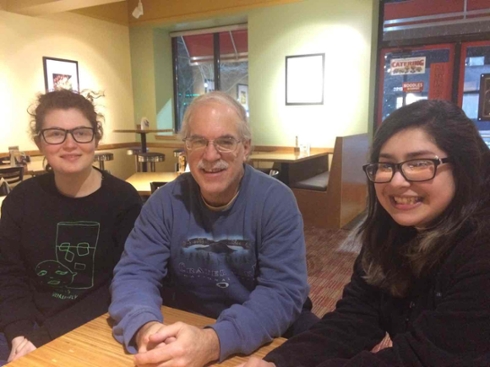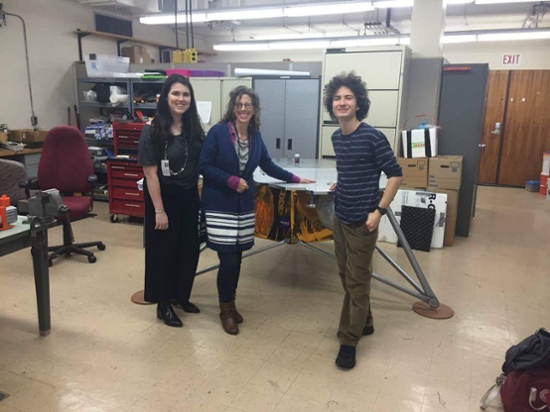Tags
"space"
NASA Ames Research Center: Evan Peairs, Winter Shadow 2016

For two days last winter I had the wonderful opportunity to shadow Arwen Dave, a systems engineer at the NASA Ames research center. I was really excited to get to spend time at Ames - having grown up in the area, I'd often passed by their gigantic wind tunnel and wondered what awesome science was at work inside. NASA Ames is different from other NASA labs in that very little of their work is actual rocket science. A lot of their work involves designing, building, and operating the missions that the rockets actually deliver. Ames has a focus on robotics research, which is the field I'm currently trying to work my way into.
This opportunity came at a critical time in my search for career paths, as I had decided to put off grad school in order to try out future job paths before committing to one in particular. My main decision for which I was gathering information was whether continuing on in academia or shifting to an industry such as engineering would put me on a better career path. Ames was the perfect place to learn about future jobs, as there is a healthy mix of scientists and engineers working in close collaboration.
My time at NASA was split between following Arwen around on her job, taking tours of some of the labs, and wandering around talking to people about their jobs. I finally got to see the inside of a wind tunnel, and got to geek out with the local machinist over their awesome equipment. Following Arwen was very informative in that, for the first time, I got to see what it is that systems engineers do with their time. It turns out that the majority of the work consists of collaborating with lots of different kinds of people to try and get a project designed and built. Working at NASA in particular seems to make the job harder, since there's tons of added bureaucracy to deal with, but also a whole lot more rewarding, since you get to see your creations put into space. Arwen tends to be working on a number of different projects at once, and had a few tips for me on how to seek out and create new work opportunities within an existing position.
Continue reading NASA Ames Research Center: Evan Peairs, Winter Shadow 2016
Astronomy at the University of Michigan: Lizzy Arellano, Winter Shadow 2016

Going to dinner
The winter shadow that I had the pleasure of going to was far more fulfilling than I ever thought it could be. My hosts were very kind. Their homes were beautiful and their hospitality was very much appreciated. Ann Arbor, Michigan, was one of the most beautiful and easy to get around towns that I’ve ever visited. Mario Mateo’s house was about 2 miles from the University of Michigan, where Sarah and I worked most of the time. We found ourselves really looking forward to the walks every day. Not only was it really nice to pass through the urban and suburban areas of Ann Arbor, but it also gave us an opportunity to explore the downtown more. The food was delicious, the sights were see-worthy, and the snow was puffy. I feel so grateful to have received this externship because I will have otherwise never been able to visit Michigan.
As for the actual project, it was a great experience overall. Not only did I learn a lot of Python, a coding language, but also, I gained experience as an intern. I learned about the actual process of working with a data set and getting real results from my work that could actually contribute to scientific process. Because we were using data from the Magellan Clay Telescope in Chile, where each fiber attached to a plate referred to a specific star in the star cluster, Omega Centauri, we were working off Mateo’s idea of a new way of star cluster analysis. We had to be very careful with our calculations, checking and rechecking for the expected results. We had to generalize our coding, so that when new data comes in, it could be analyzed using the same programs and so that people all over the world would have the opportunity to do the same type of analysis. At the end of our externship, our work rewarded us with a complete spectrum of the stars we analyzed, which allowed Mateo to analyze the spectral lines for different elements contained in the stars.
Astronomy at the University of Michigan: Sarah Racz, Winter Shadow 2016

The first thing I did when I found out I was accepted for the Winter Shadow program in Astronomy at the University of Michigan Ann Arbor was look into getting a parka. I was excited to visit Ann Arbor for the first time, and really hoping for some snow.
I stayed in Ann Arbor for a week, and left with unending love for what has become my favorite diner of all time.
I worked with a Mario Mateo, who is an astronomer at the University of Michigan. The project I worked on sought to measure the dependence of the magnitudes of RR Lyrae stars upon metal abundance. RR Lyrae stars are variable stars, known for having short periods. All the stars we observed were from the globular cluster Omega Centauri, which is a cluster known for having a range in the metallicities of its stars. All the data was from a telescope in La Serena, Chile that Mario had built. During the week I wrote several scripts in Python to read from huge files of data and run data analysis.
Wyle Labs, NASA Ames, Ali Cox, Winter Shadows 2016

The first day at Nasa Ames Research Center, Arwen showed us her office, where she keeps samples of Mars and Moon dirt analogs (formulated on Earth to resemble as closely as possible the real thing). Apparently these samples are used to test rover instruments to try to determine as best as possible how they would interact with the foreign environment. Arwen also kept pictures of all the previous groups she has worked with on various projects. Among them were a collaboration with the Japanese space agency to build a giant, human-sized centrifuge to simulate the gravity on the moon and on mars, and the construction of the solar panels of the ISS. Arwen showed us a piece of these panels. They were made of an incredibly thin material with intricate circuitry. Apparently when folded the basketball court long panel becomes only 3 inches thick, which I thought was amazing.
After this inspiring first impression of Arwen's job, we attended a meeting on a space station bio-lab Arwen's team is working on. Though there was a lot of technical talk that I didn't understand, I felt the vibe of teamwork and enthusiasm.
Many of Arwen's colleagues work on side projects with a different group of people out of their own interests. One of Arwen's side projects is a new Mars lander whose main goal is to directly search for life using a big drill, unlike previous rovers, which were apparently more concerned with geology. We got to see the life-sized wooden model of this lander built by Dave, a spacecraft expert. Dave was also nice enough to give us a tour of an ancient Titan 1 rocket. He even gave hand-outs about rocket engine principles and the many different types of rocket engines!
Continue reading Wyle Labs, NASA Ames, Ali Cox, Winter Shadows 2016
